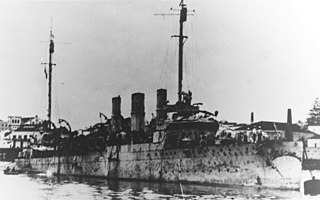
The Centaur class aircraft carrier was the final iteration of the 1942 Design Light Fleet Carrier developed by the United Kingdom for the Royal Navy during the Second World War. They were designed in 1943 to operate higher-performance aircraft than the preceding Majestic-class aircraft carrier. Four ships were laid down in 1944-1945 and completed in 1953-1959. Rapid developments in carrier warfare and technology overtook the ships even as they were under construction, and the associated costs of modernization led to ships being completed to different specifications. Only the last ship, HMS Hermes (R12), was fitted as a modern fixed-wing carrier; she was also the last of the class to retire in 2017 as INS Viraat.

The Cleveland class was a group of light cruisers built for the U.S. Navy during World War II. They were the most numerous class of light cruisers ever built. Fifty-two were ordered, and 36 were completed, 27 as cruisers and nine as light aircraft carriers. They were deactivated within a few years after the end of the war, but six were converted into missile ships, and some of these served into the 1970s. One ship of the class remains as a museum ship.

USS Conner (DD-72), a Caldwell-class destroyer, served in the United States Navy, and later in the Royal Navy as HMS Leeds.

The Oregon City class was a class of heavy cruisers of the United States Navy. Although ten ships of this class were planned, only four were completed – one of those as a command ship. The three ships completed as cruisers were in commission from 1946 to 1980, one having been converted to a guided missile cruiser (CG).

The first USS McLanahan (DD-264) was a Clemson-class destroyer in the United States Navy and transferred to the Royal Navy where she served as HMS Bradford (H72) during World War II.

USS McCawley (DD-276) was a Clemson-class destroyer built for the United States Navy during World War I. She was armed with 4 × 4 inch and 2 × 1 pounder guns. She was commissioned on 22 September 1919, served with the Pacific Fleet for 3 years and was laid up on 7 June 1922. McCawley was recommissioned on 27 September 1923, again serving in the Pacific, and decommissioned in 1930 before being sold for scrap.
USS LST-1044 was an LST-542-class tank landing ship in the United States Navy. Like many of her class, she was not named and is properly referred to by her hull designation.

The Fargo-class cruisers were a modified version of the Cleveland-class cruiser design; the main difference was a more compact pyramidal superstructure with single trunked funnel, intended to improve the arcs of fire of the anti-aircraft (AA) guns. The same type of modification differentiated the Baltimore and Oregon City classes of heavy cruisers, and to a lesser degree the Atlanta and Juneau classes of light cruisers. Changes were made in order to reduce the instability of the Cleveland-class light cruisers, especially their tendency to roll dangerously. The main battery turrets sat about a foot lower and the wing gunhouses were lowered to the main deck. The medium (40 mm) anti-aircraft mounts were also lowered.

The Juneau-class cruisers were United States Navy light cruisers that were modified version of the Atlanta-class cruiser design. The ships had the same dual-purpose main armament as USS Oakland with a much heavier secondary antiaircraft battery, while the anti-submarine depth charge tracks and torpedo tubes were removed along with a redesigned superstructure to reduce weight and increase stability. Three ships were ordered and built, all completed shortly after World War II, but only Juneau remained active long enough to see action during the Korean War.
HMS Sarawak (K591) was a Colony-class frigate of the United Kingdom that served during World War II. She originally was ordered by the United States Navy as the Tacoma-class patrol frigateUSS Patton (PF-87) and was transferred to the Royal Navy prior to completion.
This page is based on this
Wikipedia article Text is available under the
CC BY-SA 4.0 license; additional terms may apply.
Images, videos and audio are available under their respective licenses.







